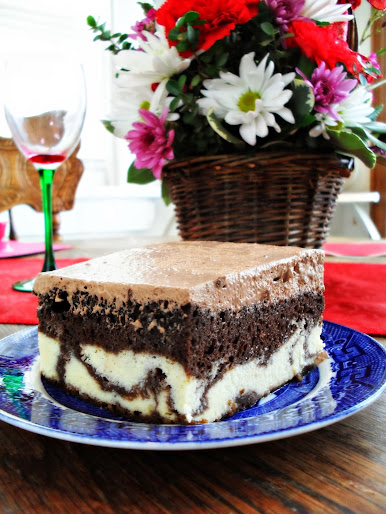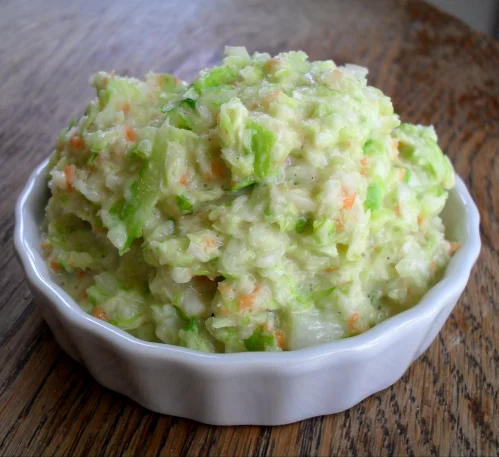
This is the red velvet cake I was telling you about that I won a blue ribbon for at this year’s state fair. It not only won a blue ribbon for the red velvet cake class, but won second best of all cakes turned in for judging from all classes! So I guess you could say this one is a winner. :)
I get 95% of the recipes I use from the web, mainly from other food blogs, but when I saw the recipe for this red velvet cake in Dam Good Sweet, I knew it was the one I had to use for the state fair competition. I could tell by reading the ingredients that it was going to be killer, and I was right!
Most recipes use white vinegar in addition to the buttermilk, which can cause the crumb to be coarse because there is too much acidity for the baking soda to neutralize. I learned this from Rose Levy Beranbaum, who has a red velvet cake recipe in Rose’s Heavenly Cakes that I almost used, but decided not to since the amount of cocoa she used was the usual paltry two tablespoons. After learning about the vinegar, however, I knew what to look for in a red velvet recipe and this one passed the test: buttermilk only.
**Update: upon re-reading Rose’s explanation of why she used buttermilk only, I see I was wrong about the vinegar. She said that baking soda neutralizes the acidity of the buttermilk which makes a coarser crumb on the cake. She uses only baking powder to keep the acidity in the cake high, thus making the vinegar unneccessary. So it’s not the acid that makes the crumb coarse, it’s the lack of it caused by the soda neutralizing the acid. So this cake DOESN’T pass her test, but now I’m thinking of making it again with baking powder only and seeing if it makes the color brighter and the crumb finer.**
This recipe has a whopping half-cup of Dutch-processed cocoa, which is more than any other red velvet recipe I’ve found, and it gives the cake a nice devil’s food flavor, far superior to the other from-scratch red velvet cakes I’ve made, where the frosting was the best part about them. With this one, the cake itself is just as good as the creamy frosting. In fact, the flavor is very similar to the Duncan Hines red velvet cake mix. This is the only cake I’ve ever made that came as close to a cake-mix taste. (Some might see this as not ideal, but cake mix cakes are my standard for the best cakes.) It is not as moist or light as the Duncan Hines red velvet, but it is still very, very good.
Dutch process cocoa has a smoother and deeper chocolate flavor than regular cocoa powder, which means while it makes the cake taste incredible, it also affects the color, making it a deep red. (I was racing against the sunset to shoot these pictures and due to the low light (and my lack of a good camera & photo editing program), the color of the cake appears darker in the first photos than it really is. The actual color is closer to these last couple photos). The deeper color doesn’t bother me, but if it bothers you, you might want to go with Rose’s recipe, which is a very bright red.
Red Velvet Cake
Printable recipe
Printable recipe with picture
For the cake:
3 cups all-purpose flour
½ cup Dutch-processed cocoa powder
1 ½ teaspoons baking powder
1 ½ teaspoons baking soda
½ teaspoon salt
2 sticks unsalted butter, room temperature
1 (1 lb) box light brown sugar (about 2 ¼ cups)
3 tablespoons red food coloring (about 1.5 oz)
2 ½ teaspoons vanilla extract
3 large eggs, room temperature
1 ¾ cups buttermilk, room temperature
For the frosting:
1 ¼ pounds (2 ½ packages) cream cheese, room temperature
1 ¼ cups (2 ½ sticks) unsalted butter, room temperature
2 teaspoons vanilla extract
1 (2 lb) bag confectioners’ sugar (about 7 ¼ cups)
To make the cake: Preheat oven to 350 degrees F. Grease and flour two 9-inch cake pans; set aside. Sift flour with the cocoa, baking powder, baking soda, and salt, and set aside.
With an electric mixer, cream the butter with the brown sugar, food coloring, and vanilla on low to combine. Increase the mixer speed to medium-high and beat until aerated and pale, about 2 minutes. Reduce the speed to medium and add the eggs, one at a time, beating thoroughly between each addition and using a rubber spatula to scrape the sides and bottom of the bowl as necessary. Reduce the speed to low and add one-third of the dry ingredients followed by half of the buttermilk. Repeat, finishing with the final third of the dry mix. Scrape down the bottom and sides of the bowl and divide the batter between the two prepared cake pans, spreading it out as evenly as possible.
Bake until tester inserted in center comes out clean and center of cake resists slight pressure, about 40 minutes. Cool on a wire rack for 10 minutes, then run a paring knife around the edges of each pan to release the cake from the sides; invert the cakes onto the cooling rack. Cool for 1 hour, then wrap each cake in plastic wrap for at least a few hours.
To make the frosting: Beat the cream cheese, butter, and vanilla together with an electric mixer on low speed to combine. Increase speed to medium-high and beat until aerated and light, about two minutes. Stop the mixer and add a few cups of the confectioners’ sugar, incorporating it into the cream cheese mixture on low speed until combined. Repeat with the remaining sugar, adding it to the mixer in two additions. Once all of the sugar is added, increase the speed to medium-high and beat until fluffy, about 1 minute.
To assemble the cake: Unwrap and cut the dome of the tops off the cakes. Break up the cake domes into a food processor fitted with blade attachment and process to crumbs; set aside. Slice each cake in half horizontally to make four layers. Ice between layers of the cakes then over the top and sides. Press the crumbs into the sides of the cake. Refrigerate at least two hours before serving.
Veronica’s notes: 1) I omitted the vanilla from the frosting because I’m used to working with much thicker frosting and didn’t want to thin this recipe any more than it already was. This kept the color lighter and the flavor didn’t seem to suffer for the omission. If I’d added it, I’m afraid it would have squooshed out between the layers as I added them, making the appearance of the finished frosted cake not as pretty. The icing did squoosh out a bit even without the vanilla, but would have been worse with it. 2) I had trouble with the cake crumbs because they were very moist and stuck together pretty badly once I processed them. I had to add a couple tablespoons of flour and process until incorporated to get them to turn into smaller crumbs. 3) I left this cake in it’s original two layers for the fair, and it made things a lot simpler. If you don’t have a lot of experience with layer cakes, I’d suggest making it two layers instead of four. 4) I had about a cup of leftover frosting after making this cake. If you like to make cake pops like I do, freeze the extra in a tub for your next cake pop/ball project. I use 1/3 cup of frosting per batch, so this will make three batches of cake pops for me.
Recipe source: Dam Good Sweet













